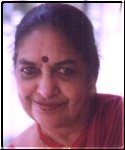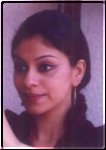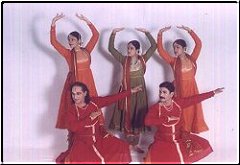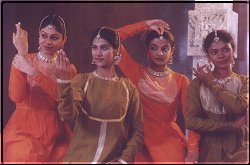
|  |

|  |
Q & A: Audience Artist Interface 21st Natyakala Conference - 2001 Chennai, India DEC 16, 2001 Maya Rao & Madhu Nataraj - Heri (Bangalore) "Kathak as a springboard for traditional and contemporary choreography" Mar 2002 
 Kathak guru Maya Rao spoke on 'Kathak as a springboard for traditional and contemporary choreography' followed by her daughter Madhu Nataraj - Heri who presented her version on the same subject. There was live demonstration as well as video excerpts to illustrate the points.   Q: How do you train your dancers when you want to do a traditional or contemporary choreography? Maya Rao: We train our dancers in all essential aspects of traditional dance and encourage them to be open to various interpretations. Our performing unit is made up of dancers from both contemporary and traditional dance backgrounds. For Kathak, we have a structured training methodology. The contemporary Indian dance ensemble has a regimen of Yoga, Indian martial arts, Kathak and contemporary dance techniques. Depending on the choreography, experts / specialists train the dancers. For e.g. if we utilize motifs of Yakshagana, Shri Shambu Hegde, an exponent of the form comes in to familiarize the unit with the finer nuances of the form and craft of Yakshagana. Q: You 2 represent 2 generations of thought. You are doing traditional as well as experimental work. Which do you present more to the pubic? Which performance is more in demand? Maya Rao: People want to see both. When programs are arranged by Sabhas and academies, they ask for traditional work. When it's a group of youngsters like corporate houses or youth festivals, they ask for contemporary. At the institute, we have started the Natya Stem Ensemble. So we start with a Ganapathy vandana, then present 1 or 2 of our traditional pieces and some contemporary work by Madhu and her group of Stem dancers. Natya Stem work is in great demand because in one evening of 90 minutes, the audience gets to see both experimental and traditional work. Q: That's a very diplomatic answer! Your productions like 'Hoysala Vaibhav' and 'Shantala' must have been in great demand. Maya Rao: I created Hoysala in the 60's. We've presented it many times, in fact we were asked to present it at the Uday Shankar Festival in Delhi just last month and Amala Shankar was full of praise for it. I have been experimenting and presenting my work for the last few decades and Madhu has been doing so for the past 4-5 years. Madhu: When we first started the Natya Stem Ensemble, people wanted to know why we mixed traditional and contemporary. When they see the work, they realize the value. Many people have a bias when they see a traditional Kathak ensemble along with a contemporary dance ensemble. We would like to say tradition will live. Of course, tradition has to live. In fact we are performing this evening in Kerala for 8,000 people - both traditional and contemporary pieces. Our aim is to generate a strong awareness and acceptance of dance. Along with our tradition, the contemporary face of Indian dance should also be show cased. Q: When you give an English name to a piece, like 'Men will be boys", we know it's a contemporary piece. Why is the floor used so much in contemporary work!! In the last piece that you showed, how much of actual dance is in it? Madhu: Yes, it is dance. In 'Men will be boys", the dance vocabulary is really vibrant with some acrobatic punctuations. The floor is used in Yoga too - one of the most organic forms of movement. For me, it is limiting to restrict dance to the extremities alone. The whole body has to communicate a movement. A contemporary piece needn't necessarily have 'English' names only. Our form is contemporary 'Indian' and is an expression of our thoughts and images, which connect to a global dance ideology. Q: In Kathak, do you do chakkars in both directions, clockwise and anti - clockwise? Maya Rao: Yes, we do. Q: And you have no problems? Maya Rao: No, we don't. Q: You do work both traditional and contemporary. For a particular subject, how do you know which will suit the piece better? Madhu: Depends on the focus- form and content. What we give the audience is how well we package it nowadays. Q: Like your collaboration with the Flamenco dancer, what sort of cross-cultural collaborations have you done? Madhu: Our studio is open to ideas and exchanges with all artistes. In fact any artiste coming to Bangalore is directed to us by the culture departments and the I.C.C R (Indian Council for Cultural Research). We collaborate with visiting dancers from India and abroad regularly. We provide a forum for artistes to conduct workshops, work with us and create new works whenever the opportunity presents itself. Similarly our overseas performance tours also include commissioned projects with dancers and musicians. To mention a few, Yugma - an Indo German dance feature for Brechts Centennial, Shakuntala and Ramayana for Soviet ballet companies, our collaborations with choreographers from U.S.A, U.K., Germany and Italy. Choreographic works created after working with folk theatre exponents in Yakshagana, Thang tha ,Chhau,etc. Our work is interdisciplinary and multicultural. Q & A: Audience Artist Interface 21st Natyakala Conference - 2001 |